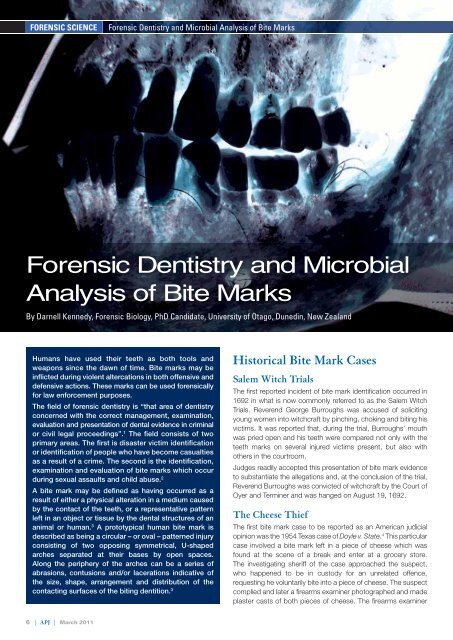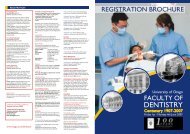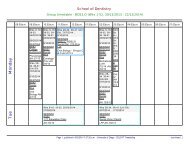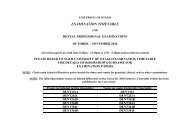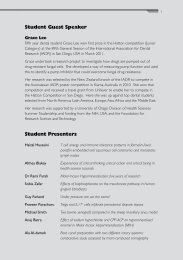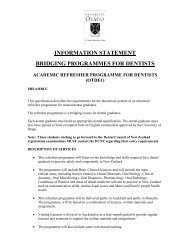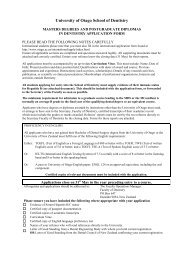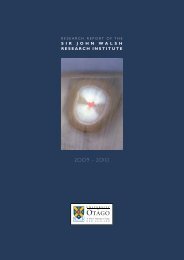Forensic Dentistry and Microbial Analysis of Bite Marks (PDF 398KB)
Forensic Dentistry and Microbial Analysis of Bite Marks (PDF 398KB)
Forensic Dentistry and Microbial Analysis of Bite Marks (PDF 398KB)
You also want an ePaper? Increase the reach of your titles
YUMPU automatically turns print PDFs into web optimized ePapers that Google loves.
FORENSIC SCIENCE<br />
<strong>Forensic</strong> <strong>Dentistry</strong> <strong>and</strong> <strong>Microbial</strong> <strong>Analysis</strong> <strong>of</strong> <strong>Bite</strong> <strong>Marks</strong><br />
<strong>Forensic</strong> <strong>Dentistry</strong> <strong>and</strong> <strong>Microbial</strong><br />
<strong>Analysis</strong> <strong>of</strong> <strong>Bite</strong> <strong>Marks</strong><br />
By Darnell Kennedy, <strong>Forensic</strong> Biology, PhD C<strong>and</strong>idate, University <strong>of</strong> Otago, Dunedin, New Zeal<strong>and</strong><br />
Humans have used their teeth as both tools <strong>and</strong><br />
weapons since the dawn <strong>of</strong> time. <strong>Bite</strong> marks may be<br />
inflicted during violent altercations in both <strong>of</strong>fensive <strong>and</strong><br />
defensive actions. These marks can be used forensically<br />
for law enforcement purposes.<br />
The field <strong>of</strong> forensic dentistry is “that area <strong>of</strong> dentistry<br />
concerned with the correct management, examination,<br />
evaluation <strong>and</strong> presentation <strong>of</strong> dental evidence in criminal<br />
or civil legal proceedings”. 1 The field consists <strong>of</strong> two<br />
primary areas. The first is disaster victim identification<br />
or identification <strong>of</strong> people who have become casualties<br />
as a result <strong>of</strong> a crime. The second is the identification,<br />
examination <strong>and</strong> evaluation <strong>of</strong> bite marks which occur<br />
during sexual assaults <strong>and</strong> child abuse. 2<br />
A bite mark may be defined as having occurred as a<br />
result <strong>of</strong> either a physical alteration in a medium caused<br />
by the contact <strong>of</strong> the teeth, or a representative pattern<br />
left in an object or tissue by the dental structures <strong>of</strong> an<br />
animal or human. 3 A prototypical human bite mark is<br />
described as being a circular – or oval – patterned injury<br />
consisting <strong>of</strong> two opposing symmetrical, U-shaped<br />
arches separated at their bases by open spaces.<br />
Along the periphery <strong>of</strong> the arches can be a series <strong>of</strong><br />
abrasions, contusions <strong>and</strong>/or lacerations indicative <strong>of</strong><br />
the size, shape, arrangement <strong>and</strong> distribution <strong>of</strong> the<br />
contacting surfaces <strong>of</strong> the biting dentition. 3<br />
Historical <strong>Bite</strong> Mark Cases<br />
Salem Witch Trials<br />
The fi rst reported incident <strong>of</strong> bite mark identifi cation occurred in<br />
1692 in what is now commonly referred to as the Salem Witch<br />
Trials. Reverend George Burroughs was accused <strong>of</strong> soliciting<br />
young women into witchcraft by pinching, choking <strong>and</strong> biting his<br />
victims. It was reported that, during the trial, Burroughs’ mouth<br />
was pried open <strong>and</strong> his teeth were compared not only with the<br />
teeth marks on several injured victims present, but also with<br />
others in the courtroom.<br />
Judges readily accepted this presentation <strong>of</strong> bite mark evidence<br />
to substantiate the allegations <strong>and</strong>, at the conclusion <strong>of</strong> the trial,<br />
Reverend Burroughs was convicted <strong>of</strong> witchcraft by the Court <strong>of</strong><br />
Oyer <strong>and</strong> Terminer <strong>and</strong> was hanged on August 19, 1692.<br />
The Cheese Thief<br />
The fi rst bite mark case to be reported as an American judicial<br />
opinion was the 1954 Texas case <strong>of</strong> Doyle v. State. 4 This particular<br />
case involved a bite mark left in a piece <strong>of</strong> cheese which was<br />
found at the scene <strong>of</strong> a break <strong>and</strong> enter at a grocery store.<br />
The investigating sheriff <strong>of</strong> the case approached the suspect,<br />
who happened to be in custody for an unrelated <strong>of</strong>fence,<br />
requesting he voluntarily bite into a piece <strong>of</strong> cheese. The suspect<br />
complied <strong>and</strong> later a fi rearms examiner photographed <strong>and</strong> made<br />
plaster casts <strong>of</strong> both pieces <strong>of</strong> cheese. The fi rearms examiner<br />
6 | APJ | March 2011
<strong>Forensic</strong> <strong>Dentistry</strong> <strong>and</strong> <strong>Microbial</strong> <strong>Analysis</strong> <strong>of</strong> <strong>Bite</strong> <strong>Marks</strong><br />
FORENSIC SCIENCE<br />
Salem Witch trials<br />
<strong>and</strong> a dentist then analysed both exhibits. The defendant was<br />
convicted as a result <strong>of</strong> the damning testimony <strong>of</strong> these two<br />
experts who believed that both pieces <strong>of</strong> cheese had been bitten<br />
by the same set <strong>of</strong> teeth.<br />
Wayne Boden Murders<br />
The Canadian judicial system was presented with its fi rst bite mark<br />
case in 1972 in the Alberta Supreme Court. More commonly<br />
referred to in the tabloid press as ‘The Vampire Rapist’, this case<br />
was the fi rst in which bite marks in human skin were used to<br />
identify the perpetrator <strong>of</strong> a bite. 5 Also noteworthy is the fact that<br />
this particular case was the fi rst in which bite mark evidence from<br />
multiple cases could be linked to a single <strong>of</strong>fender.<br />
Wayne Boden sexually assaulted <strong>and</strong> murdered four young<br />
women over a 16-month period, including one in a city some<br />
distance away from the other victims. His ‘calling card’ or<br />
‘trademark’ was to leave bite marks on his victims, particularly to<br />
their breasts. Two days following the discovery <strong>of</strong> the last victim’s<br />
body, Boden was apprehended as a possible suspect.<br />
This last victim, a 33-year-old high school teacher named<br />
Elizabeth Porteous, had suffered bite marks to one <strong>of</strong> her breasts<br />
<strong>and</strong> her neck.<br />
The police enlisted the services <strong>of</strong> a local orthodontist,<br />
Gordon Swann, in an effort to prove that the marks on Porteous’<br />
breasts <strong>and</strong> neck were Boden’s bite marks. At the time there was<br />
nothing in the Canadian forensic literature on bite mark evidence.<br />
The orthodontist then wrote to the FBI seeking their assistance.<br />
In response, the FBI referred him to an expert in Engl<strong>and</strong>.<br />
Armed with this knowledge, the orthodontist then conducted a<br />
detailed examination <strong>of</strong> these injuries in conjunction with models<br />
<strong>and</strong> wax impressions <strong>of</strong> Boden’s dentition. His analysis indicated<br />
29 points <strong>of</strong> similarity between the injuries on the victim <strong>and</strong><br />
the suspect’s dentition, thus providing enough evidence with<br />
which to positively conclude that the bite marks were infl icted<br />
by the accused.<br />
The details <strong>of</strong> the link established between Boden <strong>and</strong> the<br />
last victim sparked investigators from other law enforcement<br />
agencies to review the previous three unsolved cases that<br />
exhibited overlapping traits. The forensic odontologist from the<br />
fourth case was asked to perform an analysis on the bite marks<br />
on one <strong>of</strong> these earlier victims.<br />
Darnell Kennedy is a final year PhD student at the University<br />
<strong>of</strong> Otago, Dunedin, New Zeal<strong>and</strong>. She has a BSc <strong>and</strong><br />
PGDipSci, both in Biochemistry, from Otago. She has had<br />
a life-long interest in law enforcement <strong>and</strong> developed a<br />
passion for science at high school. Embarking on a career<br />
in the forensic science field she hopes will enable her to<br />
combine her two passions. Darnell gave a presentation<br />
in the Biological Criminalistics session at the ANZFSS<br />
International Symposium in September 2010 in Sydney.<br />
She is hoping to launch her forensic career in Australia<br />
where she intends to move upon completion <strong>of</strong> her PhD.<br />
© Darnell Kennedy retains exclusive copyright <strong>of</strong> this article <strong>and</strong> no<br />
part may be reproduced in any form or by any means, electronic or<br />
mechanical, including photocopying, recording or by any information<br />
storage <strong>and</strong> retrieval system, without prior permission in writing from her.<br />
The bite marks from both cases exhibited similarities <strong>and</strong>,<br />
as a result, police interviewed Boden in relation to the three<br />
unsolved homicides. Boden provided detailed confessions to<br />
all three <strong>and</strong> was sentenced to life imprisonment. He died in<br />
custody in 2006, from skin cancer.<br />
Ted Bundy<br />
Perhaps the most highly publicised bite mark case in United<br />
States judicial history, <strong>and</strong> possibly the catalyst for the surge<br />
in the use <strong>of</strong> bite mark evidence in courts around the United<br />
States during the 1980s, was the case involving serial killer<br />
Theodore (Ted) Bundy.<br />
Bundy was convicted <strong>of</strong> two counts <strong>of</strong> fi rst-degree murder<br />
in 1979 <strong>and</strong> was sentenced to death. The principal items <strong>of</strong><br />
evidence that resulted in Bundy’s murder convictions included<br />
the identifi cation testimony <strong>of</strong> a key witness who placed him at<br />
the scene <strong>of</strong> the crime moments before the murders <strong>and</strong> the<br />
expert analysis <strong>of</strong> teeth marks found on the body <strong>of</strong> the one <strong>of</strong><br />
the murder victims. 6<br />
Ted Bundy<br />
About the Author<br />
March 2011 | APJ | 7
FORENSIC SCIENCE<br />
<strong>Forensic</strong> <strong>Dentistry</strong> <strong>and</strong> <strong>Microbial</strong> <strong>Analysis</strong> <strong>of</strong> <strong>Bite</strong> <strong>Marks</strong><br />
Ted Bundy having dental impressions made. Photo reproduced with the<br />
permission <strong>of</strong> the State Archives <strong>of</strong> Florida<br />
Dental evidence in the trial <strong>of</strong> Ted Bundy. Photo reproduced with the<br />
permission <strong>of</strong> the State Archives <strong>of</strong> Florida<br />
Ted Bundy’s dental impressions. Photo reproduced with the permission <strong>of</strong> the<br />
State Archives <strong>of</strong> Florida<br />
The examination <strong>of</strong> the bite mark on one <strong>of</strong> the victims by a<br />
forensic odontologist involved the comparison <strong>of</strong> dental casts<br />
<strong>of</strong> Bundy’s teeth to the photographed indentations in the<br />
victim’s fl esh. During his testimony the odontologist asserted<br />
that the indentations on the victim’s body were made by Bundy.<br />
The testimony included commentary on the uniqueness <strong>of</strong> the<br />
human dentition <strong>and</strong> how the variability between individuals is<br />
such that the technique <strong>of</strong> bite mark comparison is capable <strong>of</strong><br />
providing identifi cation with a high degree <strong>of</strong> reliability.<br />
One <strong>of</strong> the issues Bundy argued during an appeal <strong>of</strong> his murder<br />
convictions was the trial court’s ruling which permitted the<br />
testimony <strong>of</strong> the dental expert who analysed the bite mark.<br />
The defence contended that the comparison techniques used<br />
during the bite mark analysis were not acceptable st<strong>and</strong>ards <strong>of</strong><br />
comparison <strong>and</strong> had not been established as reliable. Ted Bundy<br />
was unsuccessful with his appeal <strong>and</strong> the original ruling was<br />
sustained. He sat imprisoned on death row for 10 years before<br />
being executed in the electric chair on 24 January 1989 at Florida<br />
State Prison in Starke, Florida.<br />
Increasing Underst<strong>and</strong>ing <strong>of</strong> the <strong>Forensic</strong><br />
Value <strong>of</strong> <strong>Bite</strong> <strong>Marks</strong>, Victim <strong>and</strong> <strong>Bite</strong>r<br />
Demographics <strong>and</strong> Types <strong>of</strong> Crime<br />
The number <strong>of</strong> bite mark cases reported globally prior to the<br />
1950s was relatively low with most occurring in Europe or Japan.<br />
However, the number <strong>of</strong> reported bite mark cases worldwide<br />
surged in the 1970s, with many <strong>of</strong> these from the United States.<br />
During the years preceding the formal recognition <strong>of</strong> bite mark<br />
analysis as a branch <strong>of</strong> forensic odontology, appreciation <strong>of</strong> the<br />
potential value <strong>of</strong> bite mark evidence by forensic personnel at the<br />
crime scene or in the autopsy room was slow. Once high-pr<strong>of</strong>i le<br />
criminal cases, such as Ted Bundy’s demonstrated the evidentiary<br />
importance <strong>of</strong> bite marks, law enforcement personnel, coroners,<br />
pathologists <strong>and</strong> dentists were educated to carefully document<br />
bite marks for subsequent analysis.<br />
Anatomic Location<br />
In 1983, a study was conducted to focus primarily on discerning<br />
the anatomical locations <strong>of</strong> the bite marks, the sex <strong>and</strong> age <strong>of</strong><br />
victims sustaining these injuries, <strong>and</strong> the types <strong>of</strong> crime in which<br />
these injuries featured. 7 The main aim for this type <strong>of</strong> research<br />
was to provide prior knowledge <strong>of</strong> where these injuries were<br />
most likely to be found in order to assist with their initial detection.<br />
Similar studies have been conducted since this time to update<br />
<strong>and</strong> augment previous fi ndings. 8, 9 However, common to each<br />
study were the following observations:<br />
1. <strong>Bite</strong> marks are found on almost all areas <strong>of</strong> the body.<br />
2. It is common to fi nd more than one bite mark on a victim,<br />
<strong>of</strong>ten in different anatomical locations.<br />
3. <strong>Bite</strong> marks occurred primarily in sex-related crimes,<br />
child abuse cases <strong>and</strong> cases involving physical altercations<br />
<strong>of</strong> various types.<br />
4. Female victims are most commonly bitten on the breasts,<br />
arms <strong>and</strong> legs in descending order <strong>of</strong> frequency, <strong>and</strong> males<br />
most frequently bitten on the arms, back <strong>and</strong> h<strong>and</strong>s.<br />
5. Patterns <strong>of</strong> distribution <strong>of</strong> bite marks are discernable <strong>and</strong><br />
variable <strong>and</strong> are based in part by the type <strong>of</strong> crime involved,<br />
the age <strong>and</strong> sex <strong>of</strong> the victim, whether the bite mark is on the<br />
victim or the attacker <strong>and</strong> the sex <strong>and</strong> age <strong>of</strong> the perpetrator.<br />
8 | APJ | March 2011
<strong>Forensic</strong> <strong>Dentistry</strong> <strong>and</strong> <strong>Microbial</strong> <strong>Analysis</strong> <strong>of</strong> <strong>Bite</strong> <strong>Marks</strong><br />
FORENSIC SCIENCE<br />
Mould <strong>of</strong> maxillary (upper) teeth<br />
The m<strong>and</strong>ible area <strong>of</strong> a human skull<br />
Anatomy <strong>of</strong> the Typical Human <strong>Bite</strong> Mark<br />
on Skin<br />
Adult human dentition consists <strong>of</strong> 32 teeth, each <strong>of</strong> which varies<br />
in terms <strong>of</strong> its size, shape <strong>and</strong> function. The full complement <strong>of</strong><br />
teeth comprises two incisors, one canine, two premolars <strong>and</strong><br />
three molars in each upper <strong>and</strong> lower quadrant.<br />
The characteristic oval-patterned injury that results from the<br />
action <strong>of</strong> biting will typically only reveal several <strong>of</strong> the anterior<br />
teeth in each arch, namely the canines <strong>and</strong> the incisors.<br />
A very frequent observation noted during bite mark investigations<br />
is that the m<strong>and</strong>ibular (lower) anterior teeth are exhibited more<br />
clearly than the maxillary (upper) teeth. While numerous schools<br />
<strong>of</strong> thought exist as to the reason governing such a phenomenon,<br />
the most common proposal is that the m<strong>and</strong>ibular jaw is capable<br />
<strong>of</strong> movement during bite infl iction whilst the maxillary is not.<br />
Odontologists recognise a variety <strong>of</strong> characteristics within<br />
a bite injury that enable them to classify this injury as such.<br />
These vwariations <strong>of</strong> bite mark patterns are defi ned as class<br />
<strong>and</strong> individual characteristics. Class characteristics are features<br />
that distinguish a human bite mark from other patterned injuries.<br />
Individual characteristics are secondary level features within a<br />
bite mark injury that represents individual tooth variations.<br />
<strong>Bite</strong> mark dynamics can be infl uenced by many factors.<br />
These can be variations that occur during bite infl iction with<br />
both the perpetrator <strong>and</strong> victim infl uencing the resulting injury<br />
in a contrasting manner. Furthermore, variations can also occur<br />
during the recording <strong>and</strong> preservation <strong>of</strong> the evidence in addition<br />
to any external or environmental infl uences.<br />
Contentious Issues Surrounding <strong>Bite</strong> Mark<br />
<strong>Analysis</strong><br />
<strong>Bite</strong> marks <strong>of</strong>ten represent the only physical evidence found on<br />
a body. Consequently, the assessment <strong>of</strong> bite mark evidence<br />
provides the basis <strong>of</strong> the testimony presented by a forensic<br />
odontologist during criminal proceedings <strong>and</strong> the weight<br />
placed on this type <strong>of</strong> evidence can have severe consequences<br />
for suspects.<br />
Despite the continued acceptance <strong>of</strong> bite mark evidence in<br />
courts around the world, some experts in the fi eld are conceding<br />
that the scientifi c basis supporting many <strong>of</strong> the assumptions<br />
made by forensic odontologists is weak. The new level <strong>of</strong> judicial<br />
scrutiny surrounding scientifi c evidence has highlighted the<br />
defi ciencies plaguing bite mark analysis, <strong>and</strong> has thus created<br />
hotly-debated areas <strong>of</strong> contention within the fi eld <strong>of</strong> forensic<br />
dentistry. While Ted Bundy’s appeal arguments were deemed to<br />
be without merit back then, the issues on which he based his<br />
appeal are now at the forefront <strong>of</strong> the present-day debate.<br />
Uniqueness <strong>of</strong> Human Dentition – the Debate<br />
Rages<br />
<strong>Bite</strong> mark analysis is centred on two assumptions: The fi rst<br />
is that the dental characteristics <strong>of</strong> the teeth involved in biting<br />
are unique among individuals, <strong>and</strong> second, that this asserted<br />
uniqueness is registered in the material that is bitten.<br />
A forensic odontolgoist identifying an individual from their<br />
dentition will use dental x-rays <strong>and</strong> records to classify features<br />
such as dental restorations <strong>and</strong> root morphology. Contrastingly,<br />
identifying a person from a bite mark rests on an assumption<br />
that because the dentition can exhibit endless variations,<br />
this confers individual uniqueness. The major pitfall with this,<br />
<strong>and</strong> consequently the catalyst for what is now an intense<br />
debate in forensic odontology, is that this assumption has yet to<br />
be validated.<br />
Historical studies that attempted to establish the uniqueness <strong>of</strong><br />
human dentition did not address the accuracy <strong>of</strong> how various<br />
dental characteristics used to establish uniqueness are recorded<br />
in a bite mark in human skin. The most recent study that<br />
March 2011 | APJ | 9
FORENSIC SCIENCE<br />
<strong>Forensic</strong> <strong>Dentistry</strong> <strong>and</strong> <strong>Microbial</strong> <strong>Analysis</strong> <strong>of</strong> <strong>Bite</strong> <strong>Marks</strong><br />
Figure 1 Figure 2a Figure 2b<br />
Figure1. This bite mark injury was sustained in an incident that occurred a couple <strong>of</strong> days prior to being analysed by forensic dentists in Dunedin, New Zeal<strong>and</strong>.<br />
Figure 2a <strong>and</strong> 2b. A historical child abuse case (also in Dunedin) where forensic dentists were asked to review this child’s foot to determine (a) whether this was<br />
a bite mark <strong>and</strong> (b) whether it was possible to identify an individual from this injury. Photos courtesy <strong>of</strong> Pr<strong>of</strong>essor Jules Kieser<br />
attempted to fi nally shed some light on the uniqueness <strong>of</strong> human<br />
dentition used dental casts to produce bites on unembalmed<br />
human cadavers. What authors concluded from this study was<br />
that it was diffi cult to distinguish a bite from individuals with<br />
similarly-aligned dentitions. 10<br />
Accuracy <strong>of</strong> <strong>Bite</strong> <strong>Marks</strong> in Human Skin<br />
<strong>Bite</strong> mark impressions can be found in inanimate objects such<br />
as food stuffs, however it is the bite marks on human tissue<br />
that comprise the majority <strong>of</strong> bite mark investigations. The main<br />
challenge in forensic dentistry is the analysis <strong>of</strong> bite marks in<br />
human skin <strong>and</strong> this can be primarily attributed to the fact that a<br />
bite injury is subject to much distortion.<br />
The appearance <strong>of</strong> bite marks in human skin can be infl uenced<br />
by tissue distortion due to the mechanical properties <strong>of</strong> the skin.<br />
These properties are related to the underlying collagen <strong>and</strong><br />
elastic fi bres in addition to other structures such as proteoglycans<br />
(molecules found in the connective tissue <strong>of</strong> the human body).<br />
The composition <strong>of</strong> these underlying structural components<br />
varies across different locations on the body. To illustrate this<br />
simply, the underlying tissue in the back varies signifi cantly to that<br />
<strong>of</strong> the breast; therefore the degree <strong>of</strong> tissue distortion possible at<br />
each site may differ greatly.<br />
<strong>Bite</strong> mark deformation which is infl uenced by its anatomical<br />
location has fl ow-on effects on the registration <strong>of</strong> both class <strong>and</strong><br />
individual tooth characteristics. In addition, movement <strong>of</strong> the<br />
victim during bite infl iction would increase this distortion.<br />
This lack <strong>of</strong> underst<strong>and</strong>ing about the degree <strong>of</strong> distortion<br />
infl uencing a resulting bite injury creates unexplained variables<br />
that have the potential to weaken testimony in court.<br />
Current research investigating the biomechanics <strong>of</strong> skin to<br />
explain the distortion inherent in bite mark injuries is aimed at<br />
bridging some <strong>of</strong> the discrepancy that is observed between a<br />
dentition <strong>and</strong> the resulting injury. 11<br />
Another diffi culty facing forensic dentists is the changes that<br />
occur to an injury as a result <strong>of</strong> the human healing processes.<br />
Again, this is also a poorly understood area <strong>and</strong> – because the<br />
healing process is swift – this results in rapid loss <strong>of</strong> evidence if<br />
the injury is not reported immediately (Figure 1).<br />
Figures 2a <strong>and</strong> 2b show the foot <strong>of</strong> a child who had sustained<br />
physical abuse. <strong>Forensic</strong> dentists were called in to assess<br />
what may have been a bite injury to the left foot in the hope <strong>of</strong><br />
implicating someone for the abuse. Figure 2b <strong>of</strong> the underside<br />
<strong>of</strong> the foot illustrates how the healing process can make such a<br />
determination extremely diffi cult to make.<br />
DNA <strong>and</strong> its Emerging Role in <strong>Forensic</strong><br />
<strong>Dentistry</strong><br />
<strong>Forensic</strong> science is based on the premise that: ‘...every contact<br />
leaves a trace’ <strong>and</strong> this is certainly true <strong>of</strong> cases involving bite<br />
marks. Body fl uid traces recovered from a crime scene can<br />
potentially contain DNA which, like fi ngerprints, has the highest<br />
evidentiary value. In the bite mark analytical fi eld, attempts to<br />
provide a more objective mode <strong>of</strong> analysis resulted in the<br />
usefulness <strong>of</strong> saliva as a source <strong>of</strong> DNA.<br />
The advent <strong>of</strong> the dideoxynucleotide termination method <strong>of</strong><br />
sequencing DNA in 1977, followed by the development <strong>of</strong><br />
polymerase chain reaction (PCR) in 1983, has seen DNA<br />
technology take an irreplaceable position in the forensic sciences.<br />
The application <strong>of</strong> DNA technology to forensic problems was<br />
fi rst attempted in 1985 <strong>and</strong>, since that time, thous<strong>and</strong>s <strong>of</strong> cases<br />
around the world have been solved through the use <strong>of</strong> DNA-based<br />
technology. Using DNA analysis, it is possible to establish the<br />
origin <strong>of</strong> a sample that is isolated from biological materials such<br />
as blood, semen, hair roots, tissue, teeth, bone <strong>and</strong> saliva.<br />
The fi rst successful isolation <strong>of</strong> DNA from both saliva <strong>and</strong><br />
saliva-stained materials occurred in 1992 <strong>and</strong> was the work <strong>of</strong><br />
David Walsh <strong>and</strong> colleagues. 12 Researchers were aware that<br />
saliva contains sloughed epithelial cells (tissues which form a<br />
thin protective layer) from the inner surface <strong>of</strong> the lips <strong>and</strong> oral<br />
mucosa, all <strong>of</strong> which were potential sources <strong>of</strong> DNA. The team<br />
proposed a methodology to enable the extraction <strong>of</strong> DNA from<br />
this fl uid. This provided the bite mark analytical fi eld with an<br />
objective form <strong>of</strong> evidence, if successfully obtained.<br />
10 | APJ | March 2011
<strong>Forensic</strong> <strong>Dentistry</strong> <strong>and</strong> <strong>Microbial</strong> <strong>Analysis</strong> <strong>of</strong> <strong>Bite</strong> <strong>Marks</strong><br />
FORENSIC SCIENCE<br />
Numerous enzymes from a variety <strong>of</strong> sources are present in<br />
saliva. Carbohydrates, esterases, proteolytic enzymes <strong>and</strong><br />
other catabolic enzymes are produced by the salivary gl<strong>and</strong>s,<br />
oral microorganisms <strong>and</strong> leukocytes (white blood cells).<br />
Of concern to the successful recovery <strong>of</strong> DNA from saliva<br />
was the action <strong>of</strong> nucleases also present in saliva. DNA not<br />
encased within intact cells is liable to degradation by these<br />
enzymes, which has severe effects on both the quality <strong>and</strong><br />
the quantity <strong>of</strong> salivary DNA evidence.<br />
Bacteria in the Oral Cavity<br />
In addition to the proteins, glycoproteins <strong>and</strong> enzymes secreted<br />
by various gl<strong>and</strong>s <strong>and</strong> cells in the oral cavity, saliva contains<br />
a large population, both qualitatively <strong>and</strong> quantitatively,<br />
<strong>of</strong> microorganisms that have been washed or mechanically<br />
removed from their various ecological niches in the mouth.<br />
A study investigating the bacteriology <strong>of</strong> human bite wounds<br />
observed that the alpha-haemolytic streptococci were the<br />
organisms most frequently isolated from all bite wounds.<br />
The results <strong>of</strong> this study also showed that most bacteria isolated<br />
from bite wound cultures originated from the normal oral fl ora,<br />
rather than the skin fl ora. 13<br />
The human oral cavity is the gateway to our bodies.<br />
Approximately two thirds <strong>of</strong> all microorganisms gain entry<br />
through the mouth, <strong>and</strong> some <strong>of</strong> these organisms establish<br />
themselves in the oral cavity. More than 700 bacterial species,<br />
<strong>of</strong> which over 50 per cent have not been cultivated (ie. grown<br />
on culture in a laboratory), have been detected in the oral cavity.<br />
The bacterial species that predominantly inhabit the oral cavity<br />
are from the genus Streptococcus, more commonly referred to<br />
The author examining a sample<br />
as the oral streptococci or ‘strep’. There are different species <strong>of</strong><br />
streptococci (eg. Streptococcus mitis, Streptococcus gordonii)<br />
<strong>and</strong> within each species exist many subgroups, which are referred<br />
to as strains. Oral streptococci tend to be the major colonising<br />
bacteria on the surface <strong>of</strong> the teeth, however one particular<br />
species, Streptococcus salivarius, is predominant in saliva.<br />
It was assumed that because streptococci are present on the<br />
surface <strong>of</strong> the teeth, they would naturally be transferred from the<br />
teeth <strong>of</strong> a biter to the skin <strong>of</strong> the victim due to the dynamics <strong>of</strong> the<br />
biting action. Additionally, oral streptococci exhibit a large degree<br />
<strong>of</strong> genetic diversity within each species, raising the possibility<br />
<strong>of</strong> people harbouring their own unique strains <strong>of</strong> streptococci.<br />
This observable variation between the dentition <strong>and</strong> subsequent<br />
bite marks on skin <strong>and</strong> the diffi culties in recovering human DNA<br />
raised the possibility <strong>of</strong> whether a method <strong>of</strong> ‘fi ngerprinting’<br />
these bacteria would aid in the identifi cation <strong>of</strong> a suspect.<br />
Recovery <strong>of</strong> Oral Streptococci from <strong>Bite</strong> <strong>Marks</strong><br />
The concept <strong>of</strong> recovering oral bacteria from bite marks for<br />
forensic purposes was fi rst proposed in 1984 by Brown <strong>and</strong><br />
colleagues from the Department <strong>of</strong> Oral Biology at the University<br />
<strong>of</strong> Adelaide, South Australia. 14 Researchers wanted to establish<br />
the survival rates <strong>of</strong> bacteria on human skin prior to determining<br />
the possibility <strong>of</strong> a ‘fi ngerprint’ typing scheme for identifying<br />
streptococcal isolates obtained from bite marks.<br />
A minute amount <strong>of</strong> freshly-collected human saliva was<br />
applied as droplets onto the chest area <strong>of</strong> human participants.<br />
At predetermined time intervals, an area <strong>of</strong> the skin was<br />
sampled for viable (live) bacteria, specifi cally Streptococcus<br />
salivarius as it is the major species found in saliva. The rate <strong>of</strong><br />
loss <strong>of</strong> live bacteria was 45-50 per cent per hour with viable<br />
oral streptococci being recovered after 6.25 hours following<br />
application <strong>of</strong> saliva. In conclusion, these authors acknowledged<br />
that the establishment <strong>of</strong> a suitable “fi ngerprint” typing scheme<br />
for oral bacteria may provide evidence relating to the identity <strong>of</strong> a<br />
suspect in such cases.<br />
A decade later, a small research team in the Department <strong>of</strong> Oral<br />
Sciences at the University <strong>of</strong> Otago in Dunedin, New Zeal<strong>and</strong>,<br />
decided to investigate the idea <strong>of</strong> a “fi ngerprint” typing scheme<br />
as proposed by Brown <strong>and</strong> colleagues. Researchers aimed to<br />
assess the feasibility <strong>of</strong> utilising a genomic comparison approach<br />
to match Streptococcus isolates recovered from bite marks with<br />
those recovered from the incisor teeth <strong>of</strong> the biter. 15<br />
This study involved the recruitment <strong>of</strong> eight participants, none <strong>of</strong><br />
whom were using or had used antiseptic mouthwashes or had<br />
received antibiotic treatment in the previous three months,<br />
as these treatments reduce the bacterial numbers in the mouth.<br />
Participants were required to bite themselves in the bicep<br />
region (Figure 3, page 12), with as much pressure as they could<br />
tolerate, without infl icting lacerations. Researchers believed<br />
that it was critical to authenticate the transfer <strong>of</strong> bacteria from<br />
the teeth to the skin with the resulting self-infl icted bites being<br />
sampled for up to 24 hours after biting.<br />
The proposed genomic comparison approach involved the<br />
successful culture <strong>of</strong> bacterial strains from the swabs taken <strong>of</strong><br />
the experimental bite marks <strong>and</strong> the m<strong>and</strong>ibular anterior teeth.<br />
Bacterial cells were then isolated from growth media <strong>and</strong> opened<br />
to release the DNA. A comparison <strong>of</strong> the bacterial DNA pr<strong>of</strong>i les<br />
March 2011 | APJ | 11
FORENSIC SCIENCE<br />
<strong>Forensic</strong> <strong>Dentistry</strong> <strong>and</strong> <strong>Microbial</strong> <strong>Analysis</strong> <strong>of</strong> <strong>Bite</strong> <strong>Marks</strong><br />
The methodology involved taking swabbed samples from selfinfl<br />
icted bite marks <strong>of</strong> 24 participants, <strong>and</strong> from the m<strong>and</strong>ibular<br />
anterior teeth <strong>of</strong> those participants.<br />
In contrast to the previous two studies, this study circumvented<br />
the need to culture the samples onto specialised growth media by<br />
processing the samples directly. In accordance with the fi ndings<br />
from the previous two studies, the results obtained indicated a<br />
high likelihood <strong>of</strong> matching bacterial DNA amplifi ed directly from<br />
a bite mark with bacterial DNA from the teeth responsible for<br />
the bite.<br />
Current Research Shows Promising Results<br />
The three projects described above all converged on the same<br />
conclusion, which indicated the strong possibility <strong>of</strong> utilising<br />
streptococcal DNA to match a bite mark to the teeth <strong>of</strong> the biter.<br />
With all three studies providing pro<strong>of</strong> <strong>of</strong> concept that genotypic<br />
analysis <strong>of</strong> streptococci from bite marks may provide valuable<br />
forensic evidence to corroborate traditional bite mark methods,<br />
it was decided to launch another project.<br />
Figure 3. A participant demonstrating how self-inflicted bite marks were<br />
generated<br />
generated from the bite marks <strong>and</strong> the teeth <strong>of</strong> the participants<br />
revealed two interesting observations. Firstly, it was apparent<br />
that there were streptococcal strains that could be matched<br />
between both the bite mark <strong>and</strong> teeth samples. Secondly,<br />
all the streptococcal pr<strong>of</strong>i les for each <strong>of</strong> the eight participants<br />
were different. This suggested distinct bacterial pr<strong>of</strong>i les providing<br />
possible grounds for the development <strong>of</strong> a microbial genomebased<br />
approach for forensic purposes.<br />
In 2005, a slightly different team, again from the Department<br />
<strong>of</strong> Oral Sciences at the University <strong>of</strong> Otago, decided to extend<br />
the approach devised previously by applying different molecular<br />
biology tools to allow greater numbers <strong>of</strong> oral bacteria to be<br />
analysed more rapidly. 16<br />
In similar fashion to Borgula’s study, swabbed samples were<br />
taken from the m<strong>and</strong>ibular anterior teeth <strong>of</strong> eight participants,<br />
however, only one <strong>of</strong> the participants was required to produce<br />
a self-infl icted bite mark. In contrast to the prior study, a sample<br />
<strong>of</strong> a self-infl icted bite mark was obtained from one individual<br />
whose teeth samples the laboratory investigator did not have.<br />
This element <strong>of</strong> the study was not revealed to the laboratory<br />
investigator who believed that the two bite mark samples were<br />
from two <strong>of</strong> the eight participants.<br />
In accordance with the fi ndings <strong>of</strong> the previous group’s work,<br />
bacterial genotypic pr<strong>of</strong>i les from separate individuals did not<br />
match. The laboratory investigator was able to match the<br />
bacterial genotypic pr<strong>of</strong>i le obtained from one <strong>of</strong> the bite marks<br />
with that obtained from the teeth <strong>of</strong> that biter, thus correctly<br />
identifying the biter. In contrast, the bite mark sample derived<br />
from the ninth participant revealed no genotypic pr<strong>of</strong>i le that<br />
appeared in anyway similar to those obtained from the teeth <strong>of</strong><br />
any <strong>of</strong> the original eight participants.<br />
There was a revision in the methodology yet again with a third<br />
study in 2006, again by a group in the University <strong>of</strong> Otago’s<br />
Department <strong>of</strong> Oral Sciences. This study aimed to utilise<br />
sophisticated molecular tools to achieve not only a faster<br />
analysis, but a greater resolution. 17<br />
Advancements in DNA Technology<br />
The advancing technology in DNA sequencing has seen the<br />
development <strong>of</strong> an instrument capable <strong>of</strong> sequencing DNA<br />
mixtures, which is a limitation <strong>of</strong> conventional sequencing<br />
technologies. An analogy to illustrate this novel capability would<br />
be a shopping basket <strong>of</strong> groceries. Currently, when a person<br />
buys groceries, the customer is required to take each item out<br />
<strong>of</strong> the basket to be scanned individually. This is the same for<br />
conventional DNA sequencing. DNA from different origins has<br />
to be separated <strong>and</strong> sequenced individually. With the new<br />
sequencing capability, however, it is not necessary to separate<br />
DNA from different origins. Back to the shopping basket –<br />
this means the customer no longer has to take each item out<br />
<strong>of</strong> the basket. The whole basket could be passed through the<br />
scanner, with the scanner then generating an itemised printout<br />
<strong>of</strong> the contents <strong>of</strong> the basket.<br />
In terms <strong>of</strong> the different strains <strong>of</strong> streptococci present in the<br />
saliva <strong>and</strong> on the teeth, this technology provides a means with<br />
which to identify the bacterial composition <strong>of</strong> these samples.<br />
In other words, it is possible to determine the different strains <strong>of</strong><br />
oral streptococci from bite mark <strong>and</strong> teeth swabs <strong>and</strong> generate<br />
what is essentially a ‘printout’ <strong>of</strong> the strains contained within<br />
these samples. So, utilising this new sequencing technology,<br />
more accurately referred to as high-throughput sequencing,<br />
the current research aims to determine whether the streptococcal<br />
DNA sequences from a bite mark can be matched exclusively<br />
to those from the teeth responsible. Described below is a brief<br />
overview <strong>of</strong> the methodology used.<br />
1. 16 participants were recruited to bite themselves on the<br />
bicep region <strong>of</strong> one arm.<br />
2. The bite marks <strong>and</strong> the teeth were swabbed three hours<br />
after the bites were infl icted.<br />
3. PCR was used to amplify streptococcal-specifi c fragments<br />
from four loci.<br />
4. These partial DNA fragments were submitted for highthroughput<br />
sequencing.<br />
5. The sequences from the bites were compared to the teeth<br />
<strong>of</strong> the biter <strong>and</strong> the teeth <strong>of</strong> the other participants.<br />
12 | APJ | March 2011
<strong>Forensic</strong> <strong>Dentistry</strong> <strong>and</strong> <strong>Microbial</strong> <strong>Analysis</strong> <strong>of</strong> <strong>Bite</strong> <strong>Marks</strong><br />
FORENSIC SCIENCE<br />
An oral bacterial swab<br />
FLX sequencer machines<br />
March 2011 | APJ | 13
FORENSIC SCIENCE<br />
<strong>Forensic</strong> <strong>Dentistry</strong> <strong>and</strong> <strong>Microbial</strong> <strong>Analysis</strong> <strong>of</strong> <strong>Bite</strong> <strong>Marks</strong><br />
6. Statistics are being performed to determine the accuracy<br />
with which a bite mark could be correctly matched with the<br />
teeth <strong>of</strong> the biter.<br />
The criteria for eligibility to participate in this research remained<br />
unchanged from Borgula’s study described earlier. The threehour<br />
time lapse before sampling was an arbitrary time designed<br />
to mimic the delay between an incident <strong>and</strong> the presentation <strong>of</strong><br />
Figure 4. A gel photo showing DNA fragments from streptococci from the<br />
saliva (Sa), skin (S), bite (B) <strong>and</strong> teeth (T) samples <strong>of</strong> three participants.<br />
The lanes labelled M indicate the DNA markers <strong>and</strong> are included to reveal<br />
the length <strong>of</strong> the DNA fragment. The lanes labelled H2O <strong>and</strong> EC indicate<br />
water <strong>and</strong> Escherichia coli (a bacteria <strong>of</strong> another genus), are to ensure that<br />
only streptococcal DNA is capable <strong>of</strong> being amplified <strong>and</strong> are the negative<br />
control samples. The lanes labelled SG <strong>and</strong> SM indicate S. gordonii <strong>and</strong><br />
S. mitis pure cultures from which DNA was amplified from <strong>and</strong> are the positive<br />
control samples<br />
the victim to the authorities, observed in real cases. Similarly to<br />
Hsu’s study, streptococcal DNA was amplifi ed directly from the<br />
bite mark <strong>and</strong> teeth swabs to avoid the need for culturing.<br />
Before participants were asked to infl ict the experimental bites<br />
on their arms, a swab <strong>of</strong> the area <strong>of</strong> skin where the bite mark<br />
was to be located was obtained. This was to ensure that the<br />
streptococcal DNA being extracted from the bite mark originated<br />
from the teeth <strong>and</strong> not from the skin. This is exhibited in Figure 4<br />
where there is an absence <strong>of</strong> a DNA fragment for the skin samples<br />
from the three participants. The design <strong>of</strong> the DNA primers used<br />
to amplify fragments <strong>of</strong> DNA is specifi c to streptococcal bacteria<br />
only. This is also evident in Figure 4 with the absence <strong>of</strong> DNA<br />
b<strong>and</strong>s in the samples containing only water (labelled H2O on<br />
the gel photo, left) <strong>and</strong> DNA from a bacteria not belonging to the<br />
Streptococcus genus (labelled EC on the gel photo).<br />
The high-throughput sequencing technology generates numbers<br />
<strong>of</strong> DNA sequences not previously achievable with conventional<br />
sequencing. To illustrate this point, the number <strong>of</strong> sequences<br />
analysed from the bite mark samples <strong>of</strong> the 16 participants<br />
ranged from 1700–10,000 for each participant. For the teeth<br />
samples, this range was from 2600–9700 for each participant.<br />
Dealing with data <strong>of</strong> this magnitude was only going to be<br />
feasible via computational means, so a customised computer<br />
program was written specifi cally for this project. One <strong>of</strong> the<br />
requirements needed from this program was the ability to<br />
compare the sequences from each <strong>of</strong> the bite mark samples to<br />
the sequences obtained from the teeth samples to determine the<br />
proportion <strong>of</strong> shared sequences. Ideally, the greatest proportion<br />
<strong>of</strong> shared sequences was expected to be between a bite mark<br />
<strong>and</strong> the teeth responsible.<br />
T1<br />
T2<br />
T3<br />
T4<br />
T5<br />
T6<br />
T7<br />
T8<br />
T9<br />
T10<br />
T11<br />
T12<br />
T13<br />
T14<br />
T15<br />
T16<br />
B1 B2 B3 B4 B5 B6 B7 B8 B9 B10 B11 B12 B13 B14 B15 B16<br />
Table 1. Shown in this table are where the highest proportion <strong>of</strong> sequence overlap is occurring between the bite samples <strong>of</strong> the 16 participants (B1-B16) <strong>and</strong><br />
their teeth (T1-T16). Green indicates the bite <strong>and</strong> corresponding teeth samples sharing the highest number <strong>of</strong> sequences. Yellow indicates where bite <strong>and</strong><br />
corresponding teeth do not share the highest number <strong>of</strong> sequences <strong>and</strong> blue indicates the bite <strong>and</strong> non-corresponding teeth samples sharing the highest<br />
number <strong>of</strong> sequences<br />
14 | APJ | March 2011
<strong>Forensic</strong> <strong>Dentistry</strong> <strong>and</strong> <strong>Microbial</strong> <strong>Analysis</strong> <strong>of</strong> <strong>Bite</strong> <strong>Marks</strong><br />
FORENSIC SCIENCE<br />
Preliminary Results from the Current<br />
Research<br />
The sequences from each <strong>of</strong> the bite mark samples were<br />
compared to the sequences for each <strong>of</strong> the teeth samples<br />
<strong>and</strong> the proportion <strong>of</strong> shared sequences were calculated <strong>and</strong><br />
entered into a table similar to the one on page 14. The table<br />
has been colour coded to give an overview <strong>of</strong> how the bite <strong>and</strong><br />
the corresponding teeth samples have aligned. From the table,<br />
15 out <strong>of</strong> 16 bite samples shared the greatest number <strong>of</strong><br />
sequences with the teeth responsible.<br />
Currently, researchers are determining the best statistical model<br />
to use in order to predict the probability <strong>of</strong> success which, in this<br />
case, is the probability <strong>of</strong> matching a bite mark to the correct<br />
teeth based on streptococcal sequence data.<br />
The Way Forward<br />
There is a dem<strong>and</strong> on the fi eld <strong>of</strong> bite mark analysis for research<br />
to adhere to more stringent scientifi c regulations in order for<br />
it to be more resilient to scientifi c scrutiny. The foundation on<br />
which this fi eld currently st<strong>and</strong>s is fairly weak in the light <strong>of</strong><br />
new levels <strong>of</strong> scientifi c rigor. The introduction <strong>of</strong> DNA analysis<br />
provided an objective form <strong>of</strong> evidence, however the use <strong>of</strong> this<br />
technology for forensic purposes was subject to a lot <strong>of</strong> criticism<br />
before it was admitted into judicial hearings. Attempts to resolve<br />
the insecurities <strong>and</strong> misunderst<strong>and</strong>ings about such evidence<br />
led to intense scientifi c validation by scientists to establish its<br />
worth as a valuable <strong>and</strong> objective form <strong>of</strong> forensic evidence.<br />
Today, DNA is the arguably most conclusive form <strong>of</strong> forensic<br />
evidence <strong>and</strong> the scrutiny applied to DNA technology during<br />
those founding years has acted to highlight the defi ciencies in the<br />
establishment <strong>of</strong> other techniques in the forensic fi eld, including<br />
bite mark analysis.<br />
The current project aims to achieve a higher level <strong>of</strong> objectivity<br />
in terms <strong>of</strong> evidence analysis in the bite mark analytical fi eld.<br />
Research in forensic odontology has predominantly been directed<br />
at improving the techniques for the traditional morphometric<br />
means <strong>of</strong> comparing bite marks to dentitions. It is hoped that<br />
the development <strong>of</strong> this molecular-biology-based tool may<br />
prove feasible <strong>and</strong> act to corroborate any fi ndings found using<br />
traditional methods.<br />
References<br />
1. American Society <strong>of</strong> <strong>Forensic</strong> Odontology. (2007) Introduction<br />
to forensic odontology. In Manual <strong>of</strong> <strong>Forensic</strong> Odontology.<br />
(Herschaft, Alder, Ord, Rawson & Smith ed.), 4th edn rev.,<br />
pp. 1-6, Impress Printing & Graphics, New York.<br />
2. Wagner, G. N. (1997). Scientifi c Methods <strong>of</strong> Identifi cation.<br />
In <strong>Forensic</strong> <strong>Dentistry</strong>. (P. G. Stimson <strong>and</strong>, C. A. Mertz ed.),<br />
pp. 1-36, CRC Press, New York.<br />
3. American Society <strong>of</strong> <strong>Forensic</strong> Odontology. (2009). American<br />
Board <strong>of</strong> <strong>Forensic</strong> Odontology Diplomates Reference<br />
Manual. Section 3: Policies, Procedures, Guidelines &<br />
St<strong>and</strong>ards.<br />
4. Doyle v. State, 159 Tex. C.R. 310, 263 S.W.2d 779.<br />
5. Swann, G. (1974). The Wayne Boden Murders. International<br />
Journal <strong>of</strong> <strong>Forensic</strong> <strong>Dentistry</strong>, 2(4), 32-42.<br />
6. Bundy v. State 455 So 2d 330 (Fla. 1984): 349.<br />
7. Vale, G. L. <strong>and</strong> Noguchi, T.T. (1983). Anatomical distribution<br />
<strong>of</strong> human bite marks in a series <strong>of</strong> 67 cases. Journal <strong>of</strong><br />
<strong>Forensic</strong> Sciences, 28, 619-621.<br />
8. Pretty, I. A. <strong>and</strong> Sweet, D. (2000). Anatomical location <strong>of</strong> bite<br />
marks <strong>and</strong> associated fi ndings in 101 cases from the United<br />
States. Journal <strong>of</strong> <strong>Forensic</strong> Sciences, 45, 812-814.<br />
9. Freeman, A. J., Senn, D. R. <strong>and</strong> Arendt, D.M. (2005). Seven<br />
Hundred Seventy Eight <strong>Bite</strong> Mark: <strong>Analysis</strong> by Anatomic<br />
Location, Victim, <strong>and</strong> <strong>Bite</strong>r Demographics, Type <strong>of</strong> Crime,<br />
<strong>and</strong> Legal Disposition. Journal <strong>of</strong> <strong>Forensic</strong> Sciences, 50,<br />
1436-1443.<br />
10. Miller, R.G., Bush, P.J., Dorion, R.B.J. <strong>and</strong> Bush, M.A. (2009)<br />
Uniqueness <strong>of</strong> the dentition as impressed in human skin: a<br />
cadavel model. Journal <strong>of</strong> <strong>Forensic</strong> Sciences, 54, 909-914.<br />
11. Bush, M.A., Miller, R.G., Bush, P.J. <strong>and</strong> Dorion, R.B.J. (2009)<br />
Biomechanical factors in human dermal bite marks in a<br />
cadaver model. Journal <strong>of</strong> <strong>Forensic</strong> Sciences, 54, 167-176.<br />
12. Walsh, D.J., Corey, A.C., Cotton, R.W., Forman, L.,<br />
Herrin, G.L., Word, C.J. <strong>and</strong> Garner, D. (1992). Isolation <strong>of</strong><br />
deoxyribonucleic acid (DNA) from saliva <strong>and</strong> forensic science<br />
samples containing saliva. Journal <strong>of</strong> <strong>Forensic</strong> Sciences, 37,<br />
387-395.<br />
13. Goldstein, E. J., Citron, D.M., Wield, B., Blachman,<br />
U., Sutter, V.L. Miller, T.A. <strong>and</strong> Finegold, S.M. (1978).<br />
Bacteriology <strong>of</strong> human <strong>and</strong> animal bite wounds. Journal <strong>of</strong><br />
Clinical Microbiology, 8, 667-672.<br />
14. Brown, K. A., Elliot, T.R., Rogers, A.H. <strong>and</strong> Thonard, J.C.<br />
(1984). The survival <strong>of</strong> oral streptococci on human skin <strong>and</strong><br />
its implication in bite mark investigations. <strong>Forensic</strong> Science<br />
International, 26, 193-197.<br />
15. Borgula, L. M., Robinson, F.G., Rahimi, M., Chew, K.E.K.,<br />
Birchmeier, K.R., Owens, S.G., Kieser, J.A. <strong>and</strong> Tompkins,<br />
G.R. (2003). Isolation <strong>and</strong> genotypic comparison <strong>of</strong> oral<br />
streptococci from experimental bite marks. The Journal <strong>of</strong><br />
<strong>Forensic</strong> Odonto-Stomatology, 21, 23-30.<br />
16. Rahimi, M., Heng, N.C.K., Kieser, J.A. <strong>and</strong> Tompkins, G.R.<br />
(2005). Genotypic comparison <strong>of</strong> bacteria recovered from<br />
human bite marks <strong>and</strong> teeth using arbitrarily primed PCR.<br />
Journal <strong>of</strong> Applied Microbiology, 99, 1265-1270.<br />
17. Hsu, L., Power, D.A., Burton, J.P., Hauman, J.H., Tagg, J.R.<br />
<strong>and</strong> Tompkins, G.R. (2007) Comparison <strong>of</strong> streptococcal<br />
DNA amplifi ed from human bite marks <strong>and</strong> teeth by<br />
denaturing gradient gel electrophoresis. New Zeal<strong>and</strong><br />
Medical Journal, 120, 2-3.<br />
Acknowledgements<br />
I would like to thank my three outst<strong>and</strong>ing PhD supervisors,<br />
Pr<strong>of</strong>essor Jules Kieser, Dr Ge<strong>of</strong>frey Tompkins <strong>and</strong> Dr Jo-Ann<br />
Stanton. Also deserving <strong>of</strong> my appreciation is Mrs Jenine<br />
Upritchard who is the hub <strong>of</strong> the Molecular Microbiology Lab in<br />
the Department <strong>of</strong> Oral Sciences where I am based. I am grateful<br />
to the Foundation for Research, Science <strong>and</strong> Technology <strong>and</strong><br />
the New Zeal<strong>and</strong> Dental Research Foundation for their funding<br />
contributions to this project.<br />
A<br />
March 2011 | APJ | 15


